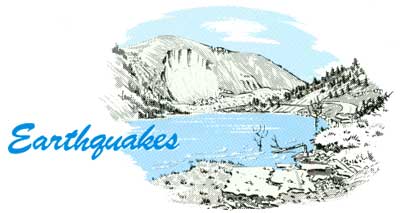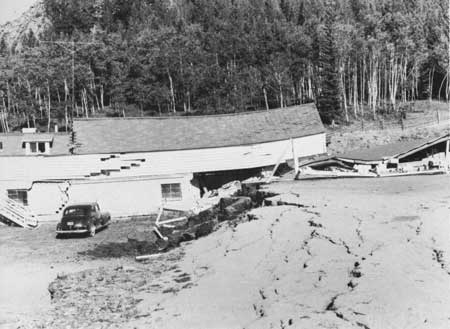
|
Geological Survey Bulletin 1347
The Geologic Story of Yellowstone National Park |
EARTHQUAKES

Earthquakes occur frequently in areas of active faulting and volcanism; they are caused by sudden movements between adjacent blocks of the earth's crust as the crust adjusts to new conditions and pressures. Because of its volcanic history and the fact that very recent fault movements have occurred there, it is not surprising that Yellowstone is an especially active earthquake area. Sensitive instruments (seismographs) record an average of about five earth tremors daily in and around the Park, and on rare occasions they may record 100 tremors or more in a single day. Nearly all these tremors are so slight that they cannot be felt by man, but at times, perhaps only once in a human lifetime, one is triggered with high enough intensity to sharply draw our attention to the very real earthquake potential that exists constantly in this geologically active area. Such a high-intensity quake occurred in the Yellowstone region near midnight on August 17, 1959.
The Hebgen Lake Earthquake, as it is known, was centered in the Madison Valley along the west boundary of Yellowstone National Park about 12 miles north of the town of West Yellowstone, Montana (fig. 1). As a result of the quake, a 200-square-mile area, occupied in part by the Hebgen Lake reservoir, subsided a foot or more; maximum subsidence was 20 feet. Movements of several feet along old faults in the highlands along the north side of the valley produced fresh scars several miles long (fig. 54). Moreover, the severe vibrations that rocked the surrounding countryside caused the loose silt, sand, and gravel of the valley floor to slip and become "faulted" in many places. By far the most drastic result was the shaking loose of a huge landslide in the vicinity of the Rock Creek campground about 25 miles downstream on the Madison River from the west boundary of the Park.

|
| EARTHQUAKE DAMAGE. Severe damage caused by reactivation of a fault during the Hebgen Lake Earthquake of August 17, 1959. The building is on the Blarneystone Ranch, about 10 miles north of West Yellowstone, Montana, and 1-1/2 miles west of the west boundary of Yellowstone National Park. (Fig. 54) |
Within Yellowstone National Park, the quake caused only slight damage to buildings at Old Faithful, Mammoth Hot Springs, and a few other places. Small landslides also occurred in various places, for example, at Tuff Cliff near Madison Junction. The earthquake affected many thermal features, particularly those in the main geyser basins near the west side of the Park. In several places the intensity of the thermal activity increased markedly, in fewer places the activity decreased. Some geysers, long dormant, erupted immediately after the earthquake; others erupted with much greater force and frequency than usual; still others became dormant and have remained so. A general, widespread effect was a noticeable increase in the muddiness of many pools and springs, as if the quake had produced a giant surge of water coursing through the underground channels of the geyser basins. Of immediate concern to everyone, of course, was the earthquake's effect on Old Faithful. Fortunately, the only measurable effect was a slight lengthening of time between eruptions. After several months the time interval stabilized at about 65 minutes.
Detailed scientific studies bearing on the Hebgen Lake Earthquake in the weeks that followed showed that it was felt over more than 600,000 square miles of the Western United States, and that it was the strongest shock ever recorded in this part of the Rocky Mountains. In 12 years' time many traces of the quake have disappeared, but its frightful aspects will not soon be forgotten. It serves as a vivid reminder, once again, of the great restlessness that through the ages has been, and continues to be, the very special trademark of the Yellowstone country.
| <<< Previous | <<< Contents >>> | Next >>> |
bul/1347/sec6.htm
Last Updated: 18-Jan-2007